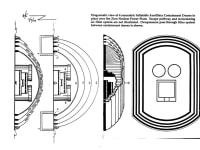In a Loss of Coolant Accident, such as those which occurred in TMI and at Fukushima, without effective cooling, the reactor core quickly overheats and begins to melt. This releases volatile radioactive elements into the pressure vessel atmosphere.
Cooling water brought into contact with an overheated and neutron-embrittled steel-reactor-pressure-vessel can cause cracks which lead to release of radioactive products. Within a matter of hours, increasing internal steam pressure, can lead to failure of the Containment Building, POSSIBLY through a tiny opening or crack, but WITH CERTAINTY BY BUILDING FRACTURES, once the internal pressure reaches 7-10 atmospheres, (EVEN IF NO EARTHQUAKE DAMAGE IS PRESENT).
In about 4 hours, after full water cooling is attempted on the core of an average 1000 Megawatt reactor, this internal pressure could easily reach this 10 atmosphere limit (10.37 tons per-square-foot internal-pressure). The entire concept of pressurized containment of radioactive gases released in a “non-design-basis accident” NEEDS TO BE RE-EXAMINED.
In the Current Entry, a Proposed Improved-Steam-and-Radioisotope-Filtration-System, with a triple-concentric tapered-interconnecting stainless-steel pipe, external "Counter-Current-Heat-Exchanger”, is attached to each Containment Building at about 9 feet above the ground level, via a 1.45 inch hole drilled through the Concrete Containment, into which a short stainless-steel pipe with a tapered external thread is secured by adhesive. This pipe is similar to the inner pipe of the concentric “double-concentric-interlocking-stainless-steel-pipe” proposed in the closed loop liquid-nitrogen cooling system proposed in my last year’s "Oil-Capture" Entry in This Contest, EXCEPT in this case, the closed-loop counter-current-cooling-system will require two additional increasingly-larger-diameter concentric-interlocking stainless-steel pipes, to provide a pathway for external cold water to chill the steam and radioactive gases escaping through the smallest most central pipe.
The central pipe will have an electronically controlled solenoid valve at the point of its junction with the small pipe inserted into the concrete containment, and a second selector solenoid valve at the distal end (of the angled triple pipe) which is used to select from an active and a back-up Filter-Canister through which the condensed steam and radioactive gases pass.
The Radiation-Shielded Charcoal-HEPA-Ferrate-Filter-Canisters are made of Transparent Aluminum Alloy, surrounded by a "Kaplan Crystalline 'Room-Temperature' Superconducting-Wire Solenoid-Electromagnet". Internal Ferrate-Powder acts to Chelate and Magnetically Trap radioactive particulates from the condensed water flowing through the central chilled pipe.
Filtered liquid can be contained within an expansible fiber-reinforced plastic-containment-bag anchored in the nearby lake, river or ocean from which the reactor obtains its cooling water.
In my (7-14-89) priorly proposed solution, a series of concentric, external inflatable Kevlar-reinforced plastic domes could be erected, in advance of an accident, around a nuclear power plant, with sequential large HEPA/electrostatic/charcoal filters between the domes which could be automatically changed by remotely controlled filter changers. One key problem with this approach was the fact that escaping steam could clog the filters. In many European reactors, there are underground sand-filled filters which can potentially be used to release internal pressure in the event of such an accident, but these are susceptible to saturation from water overload or by interruption by earthquake.
Like this entry?
-
About the Entrant
- Name:Harvey Kaplan
- Type of entry:individual
- Patent status:pending








